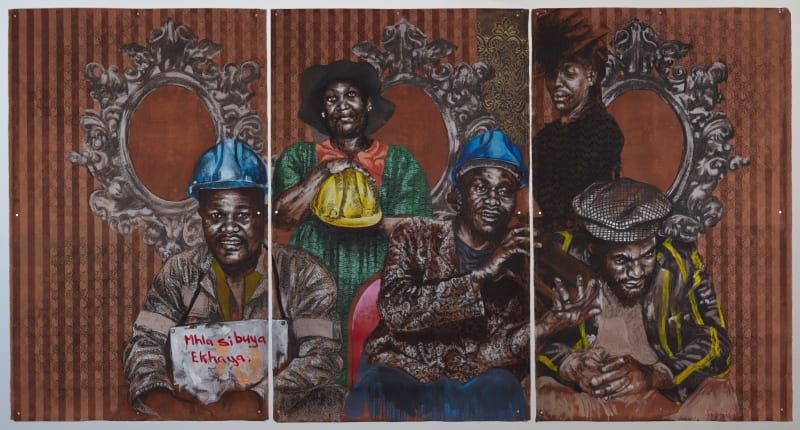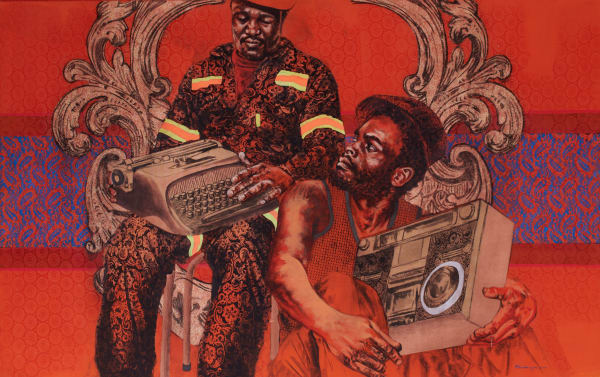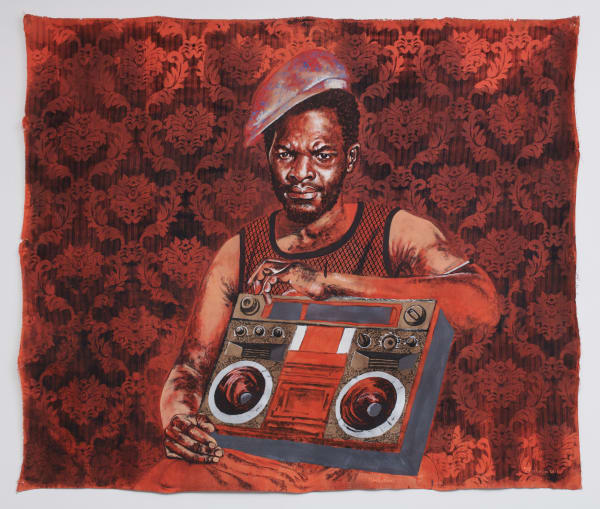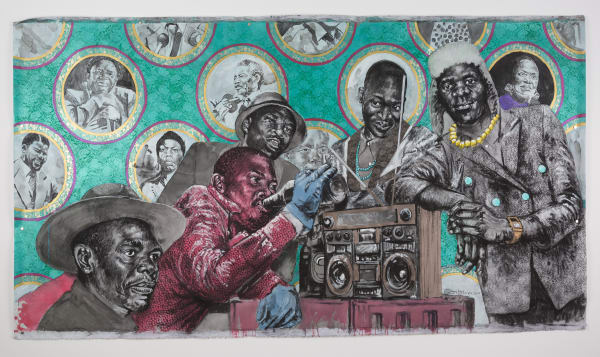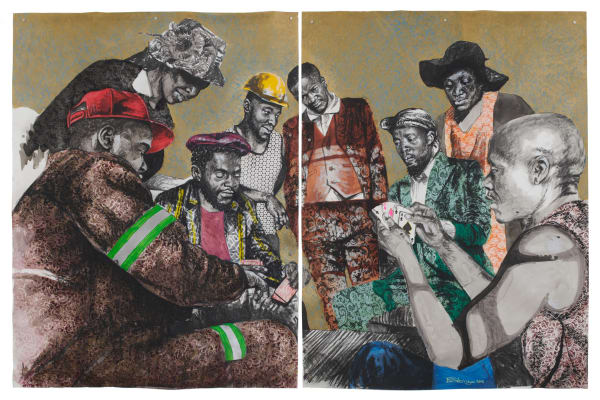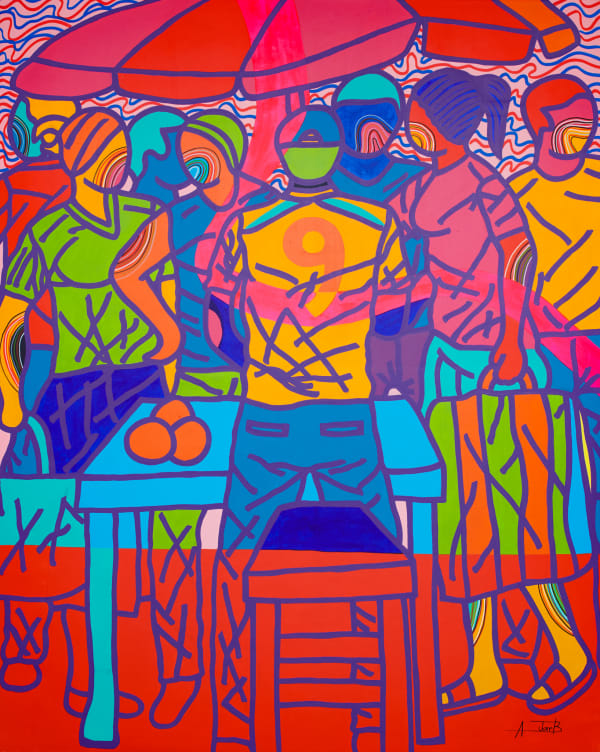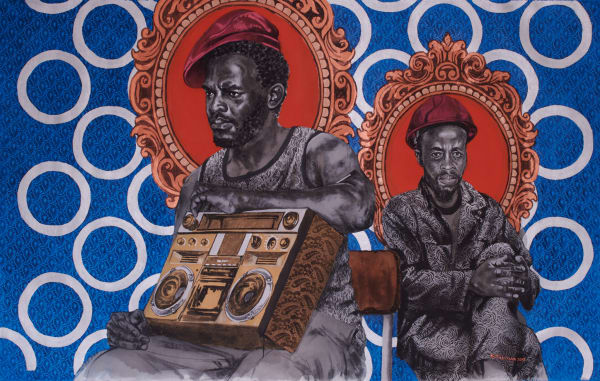Bambo Sibiya Springs, South Africa, b. 1986
Sibiya draws on traditional printmaking techniques and works with acrylic and charcoal on canvas. His work centres around the spirit of ‘Ubuntu Ngabantu’, a term deriving from Zulu philosophy and translating roughly into ‘I am what I am because of who we all are’.
My recent series focuses on early township life and each work looks into the subculture that started in the mining industry. I’m really fascinated about how the migrating community survive away from home. A lot of young men and women moved from rural areas to Johannesburg in the early days of South Africa searching for a better life. The mining industry was the main source of work and being the time of apartheid, it was not easy for a lot of black people to endure. Apart from facing the white power, they had to deal with their own social issues. But what captures my attention is how they fought back to their challenges and how they created this subculture to keep going.
Music, board games, fashion, sport and dance were important parts of daily life. We celebrate the Ladies Smith Black Mambazo today but this music was commonly known in the hostels where miners lived. They sang to free themselves from stress, from the action or pain that was inflicted on them during working hours. They would come together in the evening to sing and parody their bosses’ behaviour.
The culture of Swenkas that has spread across the world started with the hostel dwellers, who used to dress up and parade in their spare time. The Swenkas are South African workers who have found a unique way to channel their self-respect, their creativity, and their hope in the future. They inhabited a worker's hell that Apartheid created and modern South African society can't seem to dismantle. Hard lives, miserable living conditions and long separations from families would beat down even the strongest men. The Swenkas believe in cleanliness, pride, chaste behaviour, and support for one another to give themselves hope in their grim world. Healthy, humorous competition for the best-attired man gave them joy, while snappy clothing and male model performances are exercises in dignity and self-determination.
A radio played a significant role in these communities as a source of communication, a time when cell phones were not around or rather too expensive to afford. They always tuned in and listened to a program called ‘ngikhonzele’, which means please send a ‘shout out’. It was here they would come to know about the lives of their loved ones left behind at home. Their lives were dominated by the spirit of Ubuntu.
Bambo Sibiya
-
 Untitled (triptych), 2019
Untitled (triptych), 2019 -
 Township Casino (diptych), 2018
Township Casino (diptych), 2018 -
 Street Barbershop (triptych), 2018
Street Barbershop (triptych), 2018 -
 Tribute To The Loved One, 2018
Tribute To The Loved One, 2018 -
 Lamenting Upon Misrepresentation of African History, 2017
Lamenting Upon Misrepresentation of African History, 2017 -
 Paying Tribute II, 2017
Paying Tribute II, 2017 -
 Sounds of Hope, 2018
Sounds of Hope, 2018 -
 The Gathering of Swenkas, 2017
The Gathering of Swenkas, 2017 -
 Ungangibiza uTepa, 2017
Ungangibiza uTepa, 2017 -
 Umduduzi, 2017
Umduduzi, 2017 -
 Umduduzi II, 2017
Umduduzi II, 2017 -
 The Hostel Dwellers, 2017
The Hostel Dwellers, 2017 -
 The Watchers III, 2017
The Watchers III, 2017 -
 Grooming Man With Substance, 2017
Grooming Man With Substance, 2017 -
 Freedom Did Not Come, It Was Invited, 2017
Freedom Did Not Come, It Was Invited, 2017 -
 Our Family Time, 2017
Our Family Time, 2017 -
 Custodians of the Swenka Movement , 2017
Custodians of the Swenka Movement , 2017
-

Bambo Sibiya
Umdlalo Wamaphepha 14 - 28 Jun 2019Private view: Thursday 13 June, 6 - 8 pm Jack Bell Gallery is pleased to present an exhibition of new works on paper by Bambo Sibiya. The artist draws on...Read more -

Rassemblement
Group exhibition 20 Jul - 3 Aug 2018Private view: Thursday 19 July, 6 - 8 pm Aboudia Leonce Raphael Agbodjelou Ajarb Bernard Ategwa Armand Boua Goncalo Mabunda Hamidou Maiga Boris Nzebo Bambo SibiyaRead more -

Bambo Sibiya
Izikhali ze Mpilo 25 May - 8 Jun 2018Private view: Thursday 24 May 2018, 6 - 8 pm Jack Bell Gallery is pleased to present an exhibition of new paintings by Bambo Sibiya. The artist draws on traditional...Read more -

Bambo Sibiya
Ubuntu Ngabantu 7 - 21 Jul 2017Private view Thursday 6 July, 6 - 8 pm Jack Bell Gallery is pleased to present a solo exhibition of new paintings by contemporary artist Bambo Sibiya. Sibiya draws on...Read more
